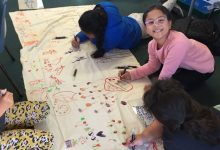NewsEducationHealth & Safety
Schools receive a C+ report card for youth PE
The University of Auckland has published a physical activity report card for NZ children and youth as part of the Active Healthy Kids Global Alliance’s Global Matrix.

According to the report card, nearly half of children and youth still do not participate in a sufficient amount of physical activity to realize the health and wellbeing benefits. Considerable room for improvement remains in the promotion of both aerobic and muscle-strengthening physical activity, particularly addressing the evident inequities in overall physical activity and across all activity indicators.
4 general recommendations from the report:
Overall, the three key recommendations from the 2018 Report Card remain unchanged but a fourth recommendation has been added to the 2022 Report Card, and a range of inequities have been highlighted across indicators based on socio-demographic characteristics.
- Develop and implement regular nationally representative surveys that enable consistent and regular measurement of key Physical Activity Report Card indicators.
- Promote all dimensions of physical activity (overall physical activity, active play, recreation, organised sport, active transport) and the reduction of screen time through policy, research, evidence-based social marketing campaigns and urban design.
- Support active transportation through investment in multi-sectoral approaches including urban planning, school and community-led initiatives and social marketing campaigns.
- Implement targeted, comprehensive, and population-specific approaches for supporting health-promoting activity behaviours and reducing inequities in these behaviours for children and youth in NZ.
Schools could do better, beyond PE and sports
Just over half of secondary school students reported that they meaningfully participate in school sport(s), the report findings illustrate, and there was a considerable decline in the proportion of children and youth enrolled in physical education when it was not mandatory.
The report card suggests that increasing opportunities for children and youth to be active at school is essential and should include options beyond school sport and physical education.
At present, NZ does not have guidelines regarding the amount of physical education (PE) required, but PE is compulsory for students in school years 1 through 10 (ages ~5-15 years).
From school year 11 onwards PE is optional, and the proportion of children and youth enrolled in PE or Health & PE as subjects declines considerably by school year based on 2019 Ministry of Education data: Year 9-10 students (87.8%), Year 11 students (42.8%), Year 12 students (28.7%), and Year 13 students (20.9%).
The school indicator grade was School C+ based on the average (55.0%) of the proportion of students ‘meaningfully’ engaged (roughly defined as participation of at least 6 weeks) in school sport according to the 2019 NZ Secondary School Sports Census (51.0%), and the proportion of children and youth who had been active in PE or class at school in the last seven days according to the Active NZ Young Peoples survey (59.0%).
Gender
A smaller proportion of children and youth identifying as another gender had been active in PE or class at school in the last seven days compared to girls and boys (35.7% versus 58.8% for girls and 59.3% for boys).
Ethnicity
A higher proportion of children and youth of Pasifika (66.7%), Māori (64.0%), and MELAA (63.6%) ethnicities had been active in PE or class at school in the last seven days compared to children and youth of European (56.8%), Asian (55.6%), and ‘Other’ (22.2%) ethnic groups.
Disability
Activity in PE or class at school in the last seven days did not differ between disabled (58.6%) and non-disabled (59.0%) children and youth.
Deprivation
A higher proportion of children and youth residing in high socio-economic deprivation areas had been active in PE or class at school in the last seven days (64.2%) than those residing in areas with lower levels of deprivation (56.6% in low deprivation areas, and 58.1%% in mid deprivation areas).
Urbanicity
The proportion of children and youth who had been active in PE or class at school in the last seven days did not differ based on urbanicity (59.9% for rural areas, 59.0% for main urban areas, and 57.5% for secondary urban areas).
Age
The proportion of children and youth who had been active in PE or class at school in the last seven days was highest among those in school years 7-10 (67.5%), followed by those in school years 0-6 (63.9%), and there was a considerably smaller proportion of those in school years 11-13 (30.8%).









